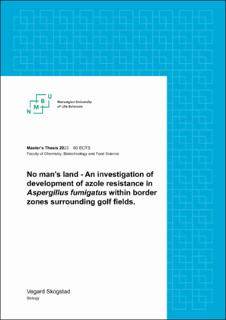| dc.contributor.advisor | Ida Skaar | |
| dc.contributor.advisor | Magdalena Monika Owczarek-Koscielniak | |
| dc.contributor.author | Skogstad, Vegard | |
| dc.date.accessioned | 2023-11-13T17:27:09Z | |
| dc.date.available | 2023-11-13T17:27:09Z | |
| dc.date.issued | 2023 | |
| dc.identifier | no.nmbu:wiseflow:6874705:55162063 | |
| dc.identifier.uri | https://hdl.handle.net/11250/3102249 | |
| dc.description.abstract | This project, conducted within the framework of the Navazole project, addressed the growing concern of azole-resistant Aspergillus fumigatus strains and their impact on humans, animals, and the environment. The aim was to investigate the potential link between the rise in resistance and the environmental use of azole antifungals.
Following a One Health approach, the project focused on screening for azole resistance in fungal isolates from soil samples collected in the border zones surrounding selected golf courses located in Viken county, Norway.
The study involved analysing soil samples collected from 11 golf courses, both before and after antifungal treatment. The susceptibility of isolated fungi to azoles was tested using VIPcheck and E-test methods.
The hypothesis proposed that golf course border zones' soil might foster azole resistance, tied to the timing of antifungal applications.
The study identified 77 A. fumigatus strains from 86 soil samples, collected from the golf courses. While no resistant strains were detected, certain samples exhibited reduced susceptibility, particularly to itraconazole. The project also explored alternative protocols for antifungal resistance screening, revealing a promising protocol which might help to mitigate economical obstacles of large scale programs.
In conclusion, the study found no evidence of azole resistance, but it did identify weakened susceptibility among some samples. These findings emphasize the ongoing importance of such studies, and underscore the necessity of continuous monitoring potential areas of resistance development to better understand the factors driving the development of azole resistance. | |
| dc.description.abstract | This project, conducted within the framework of the Navazole project, addressed the growing concern of azole-resistant Aspergillus fumigatus strains and their impact on humans, animals, and the environment. The aim was to investigate the potential link between the rise in resistance and the environmental use of azole antifungals.
Following a One Health approach, the project focused on screening for azole resistance in fungal isolates from soil samples collected in the border zones surrounding selected golf courses located in Viken county, Norway.
The study involved analysing soil samples collected from 11 golf courses, both before and after antifungal treatment. The susceptibility of isolated fungi to azoles was tested using VIPcheck and E-test methods.
The hypothesis proposed that golf course border zones' soil might foster azole resistance, tied to the timing of antifungal applications.
The study identified 77 A. fumigatus strains from 86 soil samples, collected from the golf courses. While no resistant strains were detected, certain samples exhibited reduced susceptibility, particularly to itraconazole. The project also explored alternative protocols for antifungal resistance screening, revealing a promising protocol which might help to mitigate economical obstacles of large scale programs.
In conclusion, the study found no evidence of azole resistance, but it did identify weakened susceptibility among some samples. These findings emphasize the ongoing importance of such studies, and underscore the necessity of continuous monitoring potential areas of resistance development to better understand the factors driving the development of azole resistance. | |
| dc.language | eng | |
| dc.publisher | Norwegian University of Life Sciences | |
| dc.title | No man's land - An investigation of development of azole resistance in Aspergillus fumigatus within border zones surrounding golf fields. | |
| dc.type | Master thesis | |
